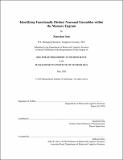Identifying functionally distinct neuronal ensembles within the memory engram
Author(s)
Sun, Xiaochen,Ph.D.Massachusetts Institute of Technology.
Download1200315052-MIT.pdf (69.61Mb)
Other Contributors
Massachusetts Institute of Technology. Department of Brain and Cognitive Sciences.
Advisor
Guoping Feng.
Terms of use
Metadata
Show full item recordAbstract
Memories in the brain are encoded by sparse ensembles of neurons within the memory engram. However, it remains unclear whether these neurons are functionally identical or can be divided into distinct subpopulations that encode distinct aspects of the memory and differently drive memory outputs. In this study, we found that contextual fear memory engrams in the mouse dentate gyrus (DG) contained functionally distinct neuronal ensembles, genetically defined by the Fos- or Npas4-dependent transcriptional pathways. The Fos-dependent ensemble promotes memory generalization and receives enhanced excitatory synaptic inputs from the medial entorhinal cortex. The Npas4- dependent ensemble mediates memory discrimination and receives enhanced inhibitory synaptic drive from local cholecystokinin-expressing interneurons. Moreover, acute deletion of Npas4 disrupted inhibitory synaptic transmission and memory discrimination, suggesting that activity-dependent genes like Npas4 and Fos play causal roles in the formation of memory engrams. Taken together, our findings support a working model in which neuronal ensembles within engrams undergo distinct learning-induced synaptic modifications and drive memory-guided behaviors differentially.
Description
Thesis: Ph. D. in Neuroscience, Massachusetts Institute of Technology, Department of Brain and Cognitive Sciences, May, 2020 Cataloged from student-submitted PDF version of thesis. Includes bibliographical references (pages 112-127).
Date issued
2020Department
Massachusetts Institute of Technology. Department of Brain and Cognitive SciencesPublisher
Massachusetts Institute of Technology
Keywords
Brain and Cognitive Sciences.